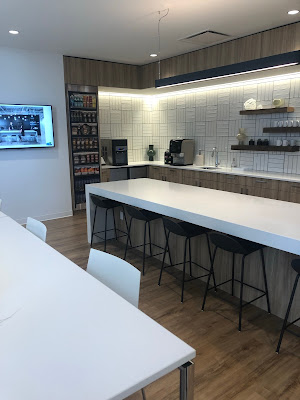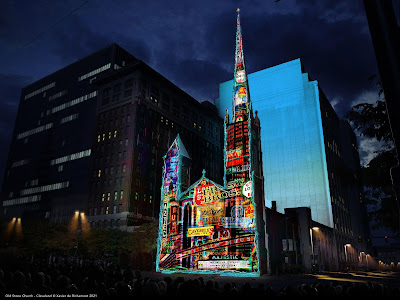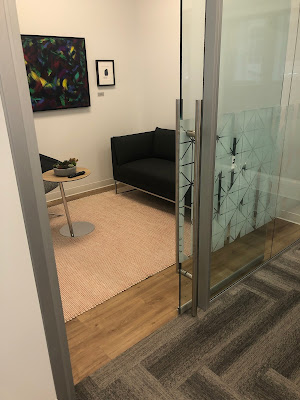An executive-level committee at Sherwin-Williams (SHW) has made a critical decision -- the final height of its new headquarters tower just west of downtown Cleveland's Public Square. According to sources on the HQ design team, the height decided by SHW's Building Our Future Committee is 600 feet.
The tower's height may actually be a few feet over 600, depending on the size of rooftop fixtures and other related structures ordered. The number of floors also approaches 40 stories, but the number isn't easy to specify since there are planned lobby mezzanines and penthouse levels that can be counted or discounted based on preference.
Over the past few months, the SHW HQ design team digitally stretched and manipulated diagrams of the proposed 1-million-square-foot tower. They made floorplates larger or smaller, added or subtracted indents and terraces in the exterior, and altered the roofline in various ways. Each of those myriad of options was presented to the committee for review and elimination until only one was left.
NEOtrans has asked for a copy of the rendering that was selected but sources are very concerned about being discovered. SHW has threatened to prosecute anyone who leaks information to media and others outside a designated inner circle. So only word descriptions and some briefing documents have been provided so far. NEOtrans is not sharing scans of the briefing documents at the request of sources.
With a final conceptual design selected, the design team will compose detailed blueprints of each floor and the exterior based on that concept and submit them to the city for approval. But it should be noted that the City Planning Commission and Building Department have been directly involved in the HQ's design.
So even though it will still be a month or two before those designs are publicly released, the city's review and approval process should move along very quickly. The city and SHW's design team have been in constant communication so neither is expecting any surprises from each other.
Here is an updated and thorough word description of SHW's new HQ complex:
- The site plan (first revealed here on NEOtrans in January a month before the public release) continues to be divided into four basic parts: HQ office tower, learning center, parking deck and future development sites.
- HQ office tower at 600+ feet tall will have an ultraviolet filter glass curtain wall exterior, square floorplates, and angled roofline similar to that of the twin Atria II or III office buildings in North York, Ontario, in suburban Toronto.
- The office building will have two outdoor terraces (NEOtrans previously reported it would have only one) in the lower mid-section of the the tower, with one terrace overlooking Public Square and the other looking in the opposite, westerly direction.
- The westerly terrace suggests no neighboring tower is anticipated by SHW in the foreseeable future as it would block views from the terrace.
- Ultra-modern, efficient and environmentally benign design of HQ is a goal so that a Leadership in Energy and Environmental Design (LEED) certification can be sought from the U.S. Green Building Council.
- High Efficiency Particulate Air (HEPA) filtration system to be provided.
- A small café will be on each floor and there will be a larger gym for employees.
- SHW logos atop the tower will face east and west.
- There will be no public uses on the ground floor of the office tower, only a lobby for employees and persons having business with SHW employees.
- So far, the only public uses on SHW-owned properties will be leasable commercial spaces along the West 3rd Street side of the parking deck.
- Frankfort Avenue, between the parking deck and tower, will be a service lane and loading zone for the SHW HQ. The city will vacate Frankfort, making it the property of SHW.
- Overhead walkways from the tower, over Frankfort to the parking deck and over West 3rd Street to the learning center, remain in the plans.
- Roughly 2.8 acres of SHW-owned land held for "future development" along West 6th Street and St. Clair Avenue will be used for trailers, equipment and materials staging during HQ construction. Afterwards it will return to use as surface parking and held for future expansion unless a developer or developers make worthwhile offers to SHW.
- The learning center on Public Square will be two stories tall. It will be comprised of conference and training facilities plus a new Center of Excellence relocated from the existing HQ in the Landmark Office Building, 101 W. Prospect Ave.
SHW hired Pickard Chilton to be the lead architect for the HQ including the exteriors. Vocon Partners LLC was chosen to design the new HQ's interiors. HGA Architects and Engineers, LLC is the base building architect for the HQ.
At a few feet over 600, SHW's new HQ will overtake Erieview Tower as the fourth tallest building in Cleveland. It will also be the sixth-tallest tower in the state of Ohio. According to WikiPedia, here are the tallest buildings in Ohio (not including antennas):
- Key Tower, Cleveland -- 947 feet -- 57 stories -- 1991;
- Terminal Tower, Cleveland -- 771 feet -- 52 stories -- 1930;
- Great American Tower, Cincinnati -- 665 feet -- 41 stories -- 2011;
- 200 Public Square, Cleveland -- 658 feet -- 45 stories -- 1985;
- Rhodes State Office Tower, Columbus -- 629 feet -- 45 stories -- 1973;
- Sherwin-Williams HQ, Cleveland -- 600+ feet -- 38-40 stories -- 2024.
Sources on the design team continue to expect shovels will go into the ground this winter for SHW's new $300+ million global HQ complex. However, contractors were already on site last week and will continue to do work over the next few months relocating utilities and doing other site preparation work for the new HQ.
SHW employees this month also began touring mock-ups of potential offices in the new HQ to provide input on conceptual interior designs, lighting, furniture, paint and artwork. After employees tour the mock-ups, located inside the existing HQ, the HQ design team will send out surveys to employees for their feedback.
Some employees at the Breen Technology Center on Canal Road and the Warrensville Technology Center on Warrensville Center Road in Warrensville Heights will relocate to the new HQ. Also relocating will be all employees (about 25) at SHW's Chicago Metro District Office in suburban Schaumburg.
With those relocations and a corporate growth factor of 8 percent, the new HQ is being designed to accommodate about 3,500 employees, according to design team members who spoke to NEOtrans on the condition of anonymity.
END














































